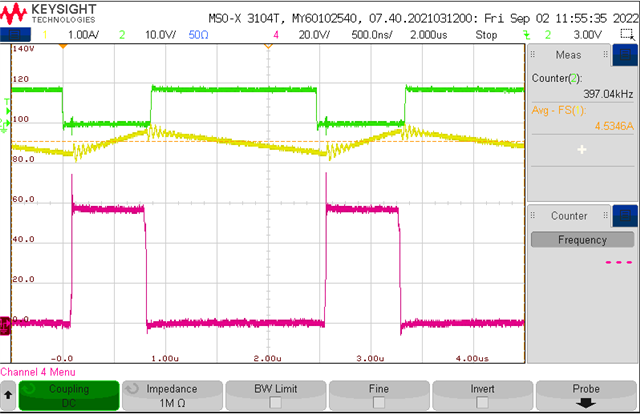Other Parts Discussed in Thread: TPS92641
Dear TI,
I'm currently designing a 4.5A LED driver which is based on your TIDA-01095 reference design. I have made a prototype PCB and currently running tests on it. We have noticed one strange behavior where the high side MOSFET gate voltage (red channel) has dropdowns of around 50ns long, while low side MOSFET gate voltage (green channel) seems correct. The diagram gives one snapshot, but the behavior is consistent for all switching cycles. From the diagram you can also notice that at LED current (yellow channel) rings almost at the same time. This strange behavior makes high side MOSFET to experience the double switching frequency (around 800kHz) compared to low side MOSFET which runs close to expected frequency (~400kHz while calculations give 380kHz). This is also causing the high side MOSFET to be major heat generator (besides the inductor) so based on your help we need to recheck thermal design to compensate this strange behavior. We are using shunt MOSFET but I guess it's not relevant to this topic because it is open all the time - the LED runs at 100%. From the TPS92641 datasheet I cannot get any details on the source of this short pulses since the logic block of the chip is not available, so far I have checked:
- overcurrent protection: doesn't fit because datasheet claims 800ns high side MOSFET turnoff while we are always at ~50ns
- overvoltage protection: I have increased the voltage LED threshold from 15V to 24V (LEDs run at around 13.5V) but still have exactly the same behavior
- Ccomp value: I have put 470nF as proposed by the datasheet and the reference design
My question is: are these dropdowns expected or there is a way to remove them? It affects our driver efficiency, the thermal design and also electromagnetic compatibility behavior.

Here are components values:
Vin=48V
VLED=13.3V
fsw=379.6kHz
Vcs=112.5mV
Rvout2=10k
Rvout1=47k
Con=1nF
Ron=14.85k
Riadj2=5.94k
Riadj1=10k
Rcs=0.025Ohm
L=47uH
Cout - not used
Rudim1=56k
Rudim2=1.8k
Rudim3=22k



